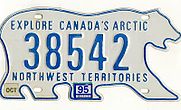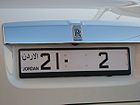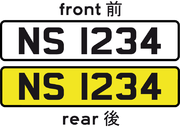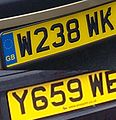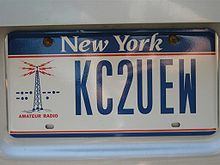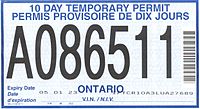- Vehicle registration plate
-
A vehicle registration plate is a metal or plastic plate attached to a motor vehicle or trailer for official identification purposes. The registration identifier is a numeric or alphanumeric code that uniquely identifies the vehicle within the issuing region's database. In some countries, the identifier is unique within the entire country, while in others it is unique within a state or province. Whether the identifier is associated with a vehicle or a person also varies by issuing agency. Depending on the country, the vehicle registration plate may be called a registration plate (UK), license plate (US), licence plate (Canada), number plate(UK), or tag (US).
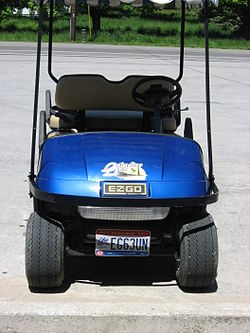 Some jurisdictions license non-traditional vehicles such as golf carts, particularly on on-road vehicles such as this one in Put-in-Bay, Ohio.
Some jurisdictions license non-traditional vehicles such as golf carts, particularly on on-road vehicles such as this one in Put-in-Bay, Ohio.
Legal requirements
Most governments require a registration plate to be attached to both the front and rear of a vehicle, although certain jurisdictions or vehicle types, such as motorcycles, require only one plate, which is usually attached to the rear of the vehicle. National databases relate this number to other information describing the vehicle, such as the make, model, color, year of manufacture, engine size, type of fuel used and mileage recorded during the vehicles annual (or bi-annual) road worthiness test, Vehicle identification (Chassis) Number and the name and address of the vehicle's registered owner or keeper.
In some jurisdictions plates will be permanently assigned to that particular vehicle for its lifetime. Some countries permit the re-registration of the vehicle with "personal" ("vanity" or "Cherished Mark") plates. If the vehicle is destroyed or exported to a different country it will require re-registering in the country of import. China requires the re-registration of any vehicle that crosses its borders from another country, such as for overland tourist visits, regardless of the amount of time it is due to remain there; thus has to be arranged with prior approval.
In others, such as U.S. states, they may require periodic changing. For cost-saving reasons the tendency for the past three decades has been to replace a small decal on the plate or to use a decal on the windshield to indicate the expiration date of the registration. Some jurisdictions follow a "plate-to-owner" policy, meaning that when a vehicle is sold the seller removes the current plate(s) from the vehicle. Buyers must either obtain new plates or attach plates that they already hold, as well as registering their vehicles under the buyer's name and the plate number. A person who sells a car and then purchases a new one can apply to have the old plates put onto this car. One who sells a car and does not buy a new one may, depending on the local laws involved, have to turn the old plates in or destroy them, or may be permitted to keep them. Other states keep the plate with the vehicle when ownership passes.
Plates are usually fixed directly to a vehicle or to a plate frame that is fixed to the vehicle. Sometimes the plate frames contain advertisements inserted by the vehicle service center or the dealership from which the vehicle was purchased. Vehicle owners can also purchase customized frames to replace the original frames. In some U.S. states license plate frames are illegal. Plates are designed to conform to standards with regards to being read by eye in day or at night or by electronic equipment. Some drivers purchase clear, smoke-colored or tinted covers that go over the license plate to prevent electronic equipment from scanning the license plate. Although perhaps useful to those avoiding detection from police, these covers are not legal in the United States[citation needed] and their use is discouraged in other countries. The British system of traffic and DVLA number recognition system cameras incorporate filter systems that make such avoidance attempt unworkable, usually with infra-red filters.
A license plate from another state can be worn on a vehicle if the jurisdiction and local laws permit it. If the local laws assign only a rear plate, it is possible to have the license plate of another state, doing so will not result in illegality.[citation needed]
Many jurisdictions have reciprocal agreements with other jurisdictions, allowing license plates from other jurisdictions to be used in their jurisdiction. For example, if a vehicle is registered in any U.S. state (including Washington, D.C. and its territories), under federal law that vehicle may be driven into any other U.S. state, and, under international agreements and treaties, into some other countries including Canada and Mexico.
History
Licence plates have been around for longer than there have been automobiles. France was the first country to introduce the licence plate with the passage of the Paris Police Ordinance on August 14, 1893,[1] followed by Germany in 1896.[2] The Netherlands was the first country to introduce a national licence plate, called a "driving permit", in 1898. The first licences were plates with a number, starting at 1. By August 8, 1899 the counter was at 168. When the Netherlands chose a different way to number the plates on January 15, 1906 the last issued plate was 2001.
In the U.S., where each state issues plates, New York State has required plates since 1901. At first, plates were not government issued in most jurisdictions and motorists were obliged to make their own. Massachusetts and West Virginia were the first states to issue plates, in 1903.
The earliest plates were made out of porcelain baked onto iron or ceramic with no backing, which made them fragile and impractical. Few of these earliest plates survived. Later experimental materials include cardboard, leather, plastic and during wartime shortages copper and pressed soybeans.
Earlier plates varied in size and shape from one jurisdiction to the next, such that if one moved, new holes would need to be drilled into the bumper to support the new plate. Standardization of plates came in 1957, when automobile manufacturers came to agreement with governments and international standards organizations. While peculiar local variants still exist, there are three basic standards worldwide.
- 520 mm by 110 or 120 mm (20.5 by 4.5 inches) - in the bulk of European countries and many of their former overseas territories.
- 372 mm by 135 mm (14.5 by 5.3 inches) - in Australia and some other Pacific Rim countries, about halfway between the dimensions of the other two standards, longer than Western Hemisphere plates but taller than European ones.
- 300 mm by 150 mm (12 by 6 inches) - in the majority of the Americas.
Vehicle registration plates by country or territory
- Lesotho
- Liechtenstein
- Lithuania
- Luxembourg
- Macau
- Macedonia
- Malaysia
- The Maldives
- Malta
- Federated States of Micronesia
- Moldova
- Monaco
- Mongolia
- Montenegro
- Mozambique
- Namibia
- Netherlands
- New Zealand
- Norway
- Pakistan
- Palestinian territories
- Paraguay
- Philippines
- Poland
- Portugal
- Qatar
- Romania
- Russia
- San Marino
- Saudi Arabia
- Serbia
- Singapore
- Slovakia
- Slovenia
- South Africa
- South Ossetia
- Spain
- Sweden
- Swaziland
- Switzerland
- Taiwan
- Thailand
- Tanzania
- Trinidad and Tobago
- Tunisia
- Turkey
- Ukraine
- United Arab Emirates
- United Kingdom
- United States
- Indian tribes
- United States Army in Germany
- Uruguay
- Yugoslavia
- Zimbabwe
Africa
Botswana
Main article: Vehicle registration plates of Botswana Cameroon license plate
Cameroon license plate
 South Africa license plate (1995)
South Africa license plate (1995)
Normal vehicles have number plates starting with the letter B, followed by three digits, followed by three letters. The digits and letters are assigned by a registrar. The three letters never include the letter Q, to avoid confusion with O. Botswana number plates have either a reflective white front and yellow rear background, and black lettering.
Government Vehicles all have the prefix "BX", the meaning of which code is unknown - these number plates have a white reflective background with red lettering at the front and white on red at the rear. After 'BX' is the last two numerals of the date of issue and then up to four serial numbers.
Botswana Defence Force vehicles have the prefix "BDF" in white on an 'army' green background.
Diplomatic vehicles' number plates start with two numerals which indicate the embassy to which they are attached, then two letters (CD (Corps Diplomatique), CC (Consular Corps status) or CT (Foreign Technical and Advisory personnel - the 'CT' abbreviation is not precisely understood) and another three digits which are serial. The official car of the Head of Mission uses the letters CMD rather that CD and the private vehicle uses CDA. This series is allocated by the Minister of Foreign Affairs.[3]
Botswana is the former British Protectorate of Bechuanaland, and number-plates then used a 'BP' prefix (then BPA, BPB etc.) followed by up to three numbers, in white on black background, the plates being made in the characteristic style of South Africa at that time.
Cameroon
Cameroon has no system of vehicle registration.
Morocco
They drive registered vehicles.
South Africa
Main article: Vehicle registration plates of South AfricaSouth African number plates are unique in each of the provinces. Each province has their own number plate design and colors, as well as numbering scheme.
Americas
Argentina
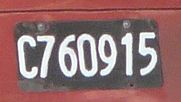 Argentina hand written LP
Argentina hand written LP Main article: Vehicle registration plates of Argentina
Main article: Vehicle registration plates of ArgentinaThe history of license plates in Argentina can be broken down in two major phases, the decentralized phase (until 1972) and the centralized one (since 1972). During the decentralized phase, license plates were assigned by each municipality or by the provinces, while during the second phase, the national state took charge of standardizing and centralizing the design and style.
Argentina uses the ABC 123 format since 1990.
Brazil
 Rear plate from Pernambuco
Rear plate from Pernambuco Main article: Vehicle registration plates of Brazil
Main article: Vehicle registration plates of BrazilBrazil adopted its current system in 1990, which uses the form ABC 1234, with a dot between letters and numbers. A combination given to one vehicle cannot be transferred to another vehicle. Above the combination there is a metallic band with the state abbreviation (SP = São Paulo, RJ = Rio de Janeiro, PR = Paraná, AM = Amazonas, etc.) and the name of the municipality. This band can be changed by breaking the seal (plastic or lead-made).
Mexico
Main article: Vehicle registration plates of MexicoEach Mexican state issues license plates of a different design. Most states change designs more or less every third year, with each state on its own plate replacement cycle. Every year Mexicans pay the "tenencia" or "revalidación de placas" (car plates renewal tax). A set of Mexican plates includes one pair of plates, a windshield sticker, and in a few states a plate sticker. In 2001 the size of the plate number was reduced to accommodate the addition of the state number, legend indicating the position of the plate on the vehicle ("delantera" (front) or "trasera" (rear)), and additional graphics. European-sized plates do exist in Mexico, but are not official or technically even legal.[4] These generally contain the same design as the standard-size plate in use at the time, and bear the standard letter and number sequence.
Mexican plates come in several different classification: Private, Private Border, Public, Public Border, Federal Public Service, Fiscal and Customs Inspection, Mexico Army, and diplomatic. The border plates were introduced in 1972 and are available in the Mexico-USA border zone. This zone is formed by the Baja California and Baja California Sur states, as well as parts of Sonora, Chihuahua, Coahuila, and Tamaulipas. While the state of Nuevo León shares a 15 km (9 mi) border with the U.S., it does not have any cities within the border zone.
United States and Canada
Main articles: Vehicle registration plates of the United States and Vehicle registration plates of CanadaAlthough license plates have only existed for just over one hundred years in the United States and Canada, they have developed a unique history that has undergone several periods and changes.
 Standard Michigan plate
Standard Michigan plate
The first license plates in the North America appeared in 1903 in the Commonwealth of Massachusetts. Soon after, other states followed suit, with virtually every state having adopted a form of license plates by 1918.[citation needed]
The first license plates in the United States were made out of leather, rubber, iron and porcelain, painted on the front in usually two different colors—one for the background and one for the lettering. This scheme held true for most states until about 1920. The front of the plate would usually contain the registration number in large digits, and in smaller lettering on one side of the plate, the two- or four-digit year number, and an abbreviated state name. Each year, citizens were usually required to obtain a new license plate from the state government, which would have a different color scheme than the previous year, making it easier for police to identify whether or not citizens were current with their vehicle registration.
 Standard New Brunswick plate
Standard New Brunswick plate
Even before 1920, some states had adopted the technique of embossing the metal plates with raised lettering and numbering, without porcelain, and applying paint all over the plate, directly onto the metal. Minnesota introduced some license plates during this period with three different years embossed into the plate, so that the plates were valid for three consecutive years (e.g., 1918, 1919, and 1920).
In the United States, license plates are issued by each state. The federal government issues plates only for its own vehicle fleet and for vehicles owned by foreign diplomats. In the United States, many Native American tribal governments issue plates for their members, while some states provide special issues for tribal members. Within each jurisdiction, there may also be special plates for groups such as firefighters or military veterans, and for state, municipality, or province-owned vehicles.
The appearance of plates is frequently chosen to contain symbols or slogans associated with the issuing jurisdiction. Some of these are intended to promote the region. A few make political statements; for example, most plates issued in Washington, D.C. include the phrase "Taxation Without Representation" to highlight D.C.'s lack of a voting representative in the United States Congress. More recently, some states have also started to put a web address pertaining to the state (such as Pennsylvania, which posts the address of its tourism site). In some states (Georgia, Iowa, Kentucky, Mississippi, Tennessee and some versions in Florida), the issuing county is listed at the bottom, while Kansas does so with a letter-coded registration sticker; Utah did so until 2003. Indiana county stickers are at the top. Alabama, Idaho, Montana, Ohio, South Dakota, Wyoming, some Nebraska and Oklahoma plates designate the county by number code (the latter with a letter) either in the plate number or registration sticker.
 Standard Pennsylvania plate
Standard Pennsylvania plate
Most states use plates onto which the letters and numbers are embossed so that they are slightly raised above its surface. Several—Alabama, Arizona, Delaware, Idaho, Indiana, Iowa, Minnesota, Montana, Nebraska, Nevada, Oklahoma, South Carolina, South Dakota, Tennessee, Texas, Wyoming, and the District of Columbia—have moved to entirely digitally produced flat license plates. Several other U.S. states now use a color thermal transfer production process that produces a flat license plate for only short-run plates such as personalized license plates and special interest plates. No flat plates have yet been introduced in Canada.
The numbering system of license plates also varies among the jurisdictions. Some states issue a motorist a serial that stays with that person as long as they live in that state, while other states periodically issue new serials and completely rotate out any old ones. Several states do not regularly use certain letters — most commonly the letters I, O, and/or Q — in their plates, except on vanity plates, so as not to confuse observers with the numbers one and zero.
When a person moves from one state or province to another, they are normally required to obtain new license plates issued by the new place of residence. Some U.S. states will even require a person to obtain new plates if they accept employment in that state, unless they can show that they return to another state to live on a regular basis. The most prominent exceptions to this policy are active duty military service members, who legally do not change residence when they move to a new posting. Federal law specifically allows them to choose to either retain the state vehicle registration of their original residence or change registration to their state of assignment.
In the United States, 19 states – Alabama, Arizona, Arkansas, Delaware, Florida, Georgia, Indiana, Kansas, Kentucky, Louisiana, Michigan, Mississippi, New Mexico, North Carolina, Oklahoma, Pennsylvania, South Carolina, Tennessee, and West Virginia – do not require an official front license plate, nor do the U.S. Virgin Islands or the territory of Puerto Rico.[5][6] In Nevada, front plates are optional if the vehicle was not designed for a front plate and the manufacturer did not provide an add-on bracket or other means of displaying the front plate.[7]
In 1956, all North American passenger vehicle license plates, except for French-controlled St. Pierre and Miquelon and the Canadian Northwest Territories and Nunavut, were standardized at a size of 6 in x 12 in (152.40 mm x 304.80 mm), although a smaller size is used for certain vehicle classes, such as motorcycles, and for the state of Delaware's historic alternate black and white plates, which are 5.25 in x 9.5 in. The plates of Nunavut and Northwest Territories are shaped like a polar bear.[8]
Canadian Forces vehicles that travel on regular roads display licence plates. These vehicles have licence plates issued by the Department of National Defence. Domestic plates were issued by the DND after 1968.
In many U.S. states, license plates are made by prison inmates.[9] Prison inmates in some Canadian provinces make licence plates.[10]
Asia
Afghanistan
 Afghanistan - diplomatic staff license plate
Afghanistan - diplomatic staff license plate
Afghan license plates primarily use Arabic script text and numerals.
India
Main article: Vehicle registration plates of IndiaThe numbers for license plates, commonly known as 'number plates' in India, are issued by the Regional Transport Office of each district but vehicle owners have private shops make the plates after registration. The scheme comprises a two letter identification for the state in which the vehicle is registered. It is followed by a two number code to identify the Regional Transport Office. The new system which is followed currently in all the states and cities came into effect in early 1990's. Each state is designated a Two Alphabet code and numerical code next after the Two digit code would define either the state which is placed alphabetically.Then the nemerical could would define the series which is followed by the number. In order to illustrate better. A number plate in the city of Punjab would be like this. PB 10 BJ 8420. PB stands for PUNJAB 10 stands for Ludhiana BJ stands for the series 8420 is for the number.
Similarly in metroploitan cities like Delhi,Mumbai,Kolkatta and Chennai. The difference is in Delhi vehicles are divided in to the wheeler capacity, where in every number plate the alpahbet 'C' denotes CAR, 'S' denotes Scooter/Motorcycle,'R'stands for rickshaw(Three wheeler), 'F' stands for FANCY number which is a different guildeline altogether. It is basically the VIP numbers become FANCY number irrespective of vehicle type for example in delhi a registration plates may apppear like these.
DL 01 C AB 0496- DL stands for delhi,01 Area or RTO authority circle, C stands for CAR, AB series,0496 is the number. Similary DL 01 S ***** would mean for Scooter/Motorcycle, Also public transpot vehicle like buses will have P in the number plate.
Recently many states have been adapting the dual letter series code system, for example car series' are CA, CB, CC; motorbike series' are MA, MB and so on.
Finally a four-digit number is used to uniquely identify the vehicle.
Most states however still use the standard series code, denoted by a single letter of the alphabet.
When the alphabet reaches Z, the length of the prefix is increased to 2. So after PY-01 9999, the next number is PY-01 A 0001 and after PY-01 Z 9999 it is PY-01 AA 0001 and so on, for example :
- MH 01 AH 5733, is a vehicle registered in Maharashtra, Maharashtra.
- TN 31 BZ 4433, is a vehicle registered in Cuddalore District, Tamil Nadu.
- AP 01 CA 2345, is a vehicle registered in Adilabad District, Andhra Pradesh.
- WB 02 A 9999, is a vehicle registered in Kolkatta, West Bengal.
- PY 01 B 6226 is a vehicle registered in Pondicherry, Pondicherry.
- DL 01 CA 2345 is a vehicle registration in Delhi, National Capital.
- GJ 14 J 9461 is a vehicle registration in Amreli District Gujrat
- KA 01 MB 666 is a vehicle registration in Bangalore, Karnataka.
- KL 07 BS 666 is a vehicle registered in Kochi, Kerala.
Many people use illegal ways of number plating, like writing in regional script instead of Latin (Roman).They use regional language script like Devanagari, Kannada, Tamil etc. Many of them use plates influenced by EU plates; they have blue band on initial letters.Indonesia
Main article: Vehicle registration plates of IndonesiaCurrent Indonesian license plates share the legacy of the Dutch colonial era. They do not reflect the current regional divisions of the country into provinces, but rather maintain the old system of Dutch Karesidenan regions or regencies. Their prefixes are therefore based on this system. Basically there are four types of plates are used in Indonesia which consists of a combination of alphabet and numbers. For commercial vehicles, the plate has a yellow background and black numbering. For private vehicles, a black background with white letters. For government vehicles, the plates has red background with white fonts. Dealer plates are white backgrounds with red fonts. Besides these normal plates there are also military plates for Army, Navy, Air Force, and also the Police. While diplomatic corps get special white plates and black numbering with "CD" prefix. The normal scheme comprises a one or two letters identification for the regencies, followed by an up to four digit number to uniquely identify the vehicle, and the last one to three letters are the serial code or district identification. The expiry date of the license is embossed along the bottom of the plate.
e.g.:
- B 1234 CD, is a vehicle registered in Jakarta (formerly Batavia) capital area.
- In Jakarta, vehicles from year of 2009 and later start using three letter suffix, B 1234 ABC
- L 123 MN, is a vehicle registered in Surabaya, provincial capital of East Java (Jawa Timur).
- KT 8910 T, is a vehicle registered in East Kalimantan Province, Tarakan municipality, on Borneo island.
All of the plates usually have their expiration dates shown on a bar below the serial numbers depicting the expired month and the year; or for temporary plates, the expiration date and month.
Iran
Main article: Vehicle registration plates of IranThe license plates of Iran have a white background and are in the format: ##@###|XX. XX and @ depends on the province and county that car belongs to. In the license plate of governmental cars the background is red, the numbers are white and the @ is الف. For Taxis the @ is a small ت at the bottom and a TAXI at the top. In public cars (buses and trucks) the @ is an ع as in عمومي means public.
Iraq
 Iraq license plate - 2001
Iraq license plate - 2001 Main article: Vehicle registration plates of Iraq
Main article: Vehicle registration plates of IraqJapan
Main article: Vehicle registration plates of JapanJapanese vehicle registration plates fall into two classes: Prefectural, used nationwide, and Municipal. Municipal registration is typically applicable to motor vehicles that will not leave the area, such as light motorcycles.
In the prefectural system, the top line names the office at which the vehicle is registered, and includes a numeric code that indicates the class of vehicle. The bottom contains one serial letter (typically a kana), and up to four digits. The classes of registration plate are divided by vehicle type and engine size. For private vehicles less than 660cc, registration plates have black text on a yellow background. Above 660cc, a white plate with green text is used. For commercial, non-private vehicles, the colors of the numberplate are inverted. An official seal is applied over one (typically the left) screw, preventing the plate being removed and applied to another car.
Municipal registration plates in Japan may vary in color and design.
Jordan
Jordan requires its residents to register their motor vehicles and display vehicle registration plates.
Pakistan
Main article: Vehicle registration plates of PakistanEight types of license plates are used in Pakistan. Each province and territory issues its own number plate; the federal government issues number plates for foreign diplomats and vehicles owned by the military, police and federal departments (red for foreign diplomats and green for the federal government.) Sindh's number plates are yellow with black letters and numbers for private vehicles and Black number plates with white letters for commercial vehicles; Islamabad, NWFP, Azad Jammu and Kashmir, Balochistan and Northern Areas have white number plates with black letters and numbers. The number plates also have the province or territory's name at the bottom. In Punjab however, number plates can be of any color the vehicle owner chooses. But legally it is not allowed. The first 2 letters represent the city the vehicle is registered in.
From January 1, 2007 Punjab has started issuing official number plates for all cars registered in Punjab. Number plates are of Green and White color. The green part is the same all over Punjab and has a sign and 'Punjab' written on it, while the white part has the number of the vehicle.
For example:
- RIZ 3725, is a vehicle registered in Rawalpindi, Punjab.
- MNA 6762, is a vehicle registered in Multan, Punjab.
- LEL 06 4520, is a vehicle registered in Lahore, Punjab. (07 represents year 2009)
All number plates use the Latin alphabet.
People's Republic of China
 Blue PRC licence plates of the 1992 standard (August 2004 image)
Blue PRC licence plates of the 1992 standard (August 2004 image)
The People's Republic of China issues vehicles license plates at its Vehicle Management Offices, under the administration of the Ministry of Public Security.
The current plates are of the 2007 standard (GA36-2007), which consist of the one-character provincial abbreviation, a letter of the Latin alphabet corresponding to a certain city in the province, and five numbers or letters of the alphabet (e.g. 京A-12345, for a vehicle in Beijing or 粤B-12345 for a vehicle from Shenzhen in Guangdong province). The numbers are produced at random, and are computer-generated at the issuing office. (A previous licence plate system, with a green background and the full name of the province in Chinese characters, actually had a sequential numbering order, and the numbering system was eventually beset with corruption).
Yellow plates are issued for large vehicles of Chinese nationality. Blue plates, the most common sort, are issued for vehicles of Chinese nationality, which are small or compact in size. Black plates are issued for vehicles belonging to foreigners and persons from Hong Kong and Macau. Please note this is the license plates for the car originated from Hong Kong or Macau and traveling in mainland China, which means the car has two sets of license plates, this one for use in mainland China, while the other one is the original Hong Kong/Macau license, which is totally different from this numbering system and colors. And it is not easy to get two licenses on the car unless the owner has significant investment in mainland China. For other Hong Kong / Macau cars which have just one license, they can only operate in Hong Kong or Macau respectively. The mainland Chinese plates of these cars follow the pattern of the provincial character for Guangdong (粤), the Latin letter "Z", 4 letters and/or numbers, ending in the abbreviated character for the territory (e.g. 粤Z-AE54港 for Hong Kong) (Black license plates are handed to vehicles of any size, as long as they are from one of the special administrative regions.)
Hong Kong
Hong Kong number plates follow British system of coloring, with front white and rear yellow plates. Numbering system is two letters and (up to) four digits, e.g. AB1234. License numbers start from "AM" are government cars. The front white and rear yellow background is a reflective material comply to BS AU145a standard.
In addition, Hong Kong started to have personalize license plates from 2006, with up to 8 selectable letters or numbers.
Macau
Macau local license plates follow the Portuguese pre-1992 system of color and sequence. Plates are black background with white numbers. Numbering system starts from M, and then one letter, and then 4 numbers, and separated by "-", e.g. MA-12-34. Earlier numbers will only have M instead of MA or MB or MC.... etc...
North Korea
North Korean vehicle plates follow the pattern XX-##-###, where "XX" is replaced with two Hangul characters spelling the province name.
The most common plates are embossed black-on-white to indicate state ownership; plates indicating KPA use are white-on-black. Motorcycle plates are black-on-yellow or black-on-orange. The very few privately owned motor vehicles which exist in North Korea bear black-on-red plates, while diplomatic plates are white-on-blue. Other types of vehicles (trolleys, emergency vehicles, buses/taxis) are indicated with additional numerical prefixes.
Russian Federation
There are six types of Russian registration plates.
Main article: Vehicle registration plates of Russia- Civil plates - civil plates have white background with black numbers. The templates for number is "@###@@ | RR" where @ is one of the "ABCEHKMOPTXУ" letters (Cyrillic letters that can be recognized by those familiar with the Latin alphabet, but actually correspond to AVSENKMORTHU), # is a digit and RR is a region number (2 or 3 digits).
- Government plates - government plates have white background with black numbers. The templates for number is "@###@@ | FL" where FL is a tricolor flag of Russia (canceled in 2007).
 Saudi Arabia license plate - ('70s)
Saudi Arabia license plate - ('70s)
- Police plates - blue background and white characters.
- Diplomatic plates - red background and white characters.
- Military plates - black background and white characters.
- Route vehicles (buses, trolleys and fixed-run taxies) - yellow background and black characters with "@@### | RR" template.
Saudi Arabia
Europe
Main article: Vehicle registration plates of EuropeIn the European Union, white or yellow number plates of a common format and size are issued throughout, although they are still optional in some member states. Nevertheless, some individual member states still use differing non-EU formats - Belgium, for example, still permits vehicles to display the older small white number plates with red lettering, and the license plates that are issued by the government body which assigns these are of the smaller format, too. In 1908 number plates were only 3 Numbers and 1 letter long. Italy still permits smaller plates to be attached to the front of a vehicle, while the rear plate complies to the usual EU format. The common design[11] consists of a blue strip on the left of the plate, which has the EU motif (12 yellow stars), along with the country code of the member state in which the vehicle was registered.
Lettering on the plate must be black on a white or yellow reflective background. With this EU format, vehicles are no longer required to carry an international code plate or sticker for traveling between member states. The non-EU states of Switzerland, Norway and Turkey also recognise the blue strip instead of the traditional white oval with the country code in black.
Germany has selected a typeface which is called fälschungserschwerende Schrift (abbr.: FE-Schrift), meaning "falsification-hindering script". It is designed so that, for example, the O cannot be adjusted to look like a Q, or vice versa; nor can the P be painted to resemble an R, amongst other changes. This typeface can more easily be read by radar or visual license-plate reading machines, but can be harder to read with the naked eye, especially when the maximum allowed number of 8 characters in "Engschrift" (narrower script used when available space is limited) are printed on the plate.
Diplomatic plates are usually denoted by the letters "CD" in Europe which stands for Corps Diplomatique located usually at the beginning of the number plate (France, Belgium) or middle (Holland). The United Kingdom uses "D" for "diplomat".
-
Car registration plate from Turkey. - since 1968
-
Manx (not in the EU) car registration plate
-
Lithuanian plate issued shortly before EU membership. The same format is still used, except with the EU logo instead of the country flag.
-
Danish common registration plate (2009 style)
-
Old and new (2010) style Belgian plates
-
A standard Hungarian registration plate.
-
Location anonymous license plate in Bosnia and Herzegovina
-
Fälschungserschwerende Schrift, used on German plates to hinder falsification. Note that normally similar glyphs (e.g. O and Q) are distinct in shape.
-
A standard Finnish license plate
-
Car registration rear plate of Jersey (British, not in the EU)
-
A standard Slovenian registration plate from Nova Gorica.
-
A standard Russian license plate
-
Car number plate from the unrecognized territory of Transnistria. Instead of a country code there is a holographic sticker
-
Registration plate from Croatia with region code, numbers and letter in alphabet.
-

Vatican City Registration Plate (in this case, for the Popemobile)
-
Vatican City Registration Plate (official vehicles)
-
Vatican City Registration Plate (residents of the city-state)
-
Vehicle registration plate for the Sovereign Military Order of Malta
-
(introduced in 2010)
Australia and Oceania
Australia
 Standard Victorian plate
Standard Victorian plate
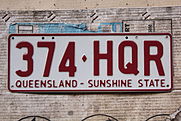 Queensland license plate
Queensland license plate
 Northern Territory license plate
Northern Territory license plate
 Western Australia license plate
Western Australia license plate Main article: Vehicle registration plates of Australia
Main article: Vehicle registration plates of AustraliaIn Australia, vehicle registration plates, usually known as number plates, are normally issued by the State or Territory government; until 2000 some were issued by the Commonwealth government. Plates are associated with a vehicle and generally last for its life, though as they become unreadable (or for other reasons) they may be recalled or replaced with newer ones. New plates are issued when the vehicle is registered in another state, or if the owner requests them (though this depends on state laws).
Australian number plates were originally issued with white characters on black plates, with each state and territory being allocated a range of plates inside the larger range AAA000 to ZZZ999. New South Wales, for example, was allocated AAA000 to FZZ999, Victoria was allocated from GAA000, Queensland was allocated OAA000 to QZZ999 and South Australia was allocated from RAA000. Western Australia was allocated UAA00 and XAA000 .This system worked in theory but was soon altered in practice and by 1980 had been almost completely abandoned, with some states having run out of combinations. Tasmania and the Northern Territory never adopted the system, but the Australian Capital Territory held out to the late 1990s.
The states then chose their own systems. New South Wales, Victoria and South Australia all retained xxx-nnn, but each started again from AAA-000. Queensland reversed the arrangement to nnn-xxx. Western Australia took nxx-nnn, and the ACT kept the Y plate range but substituted the last digit for a letter, giving Yxx-nnx. Victoria is currently the last state to retain the xxx-nnn format as South Australia scrapped the old format as of 1 October 2008.
Current arrangements are listed below.
All current plates are manufactured to uniform dimensions and are made of pressed aluminium, except for certain special series plates; the form of which differs by state and design.
In 1942 Government release new special series only alphabet (XB-AA OPS)
Current standard Australian number plate formats (As at 22/2/2011)
Note: 'x' represents a sequential letter, 'n' represents a sequential number. This list excludes special issue or personalized plate designs.- Australian Capital Territory: Blue text on white background, with "ACT" above and "CANBERRA - THE NATION'S CAPITAL" below.
Code format: Yxx-nnx - New South Wales: Black text on yellow background, with "NEW SOUTH WALES" below the plate code. Also in circulation are plates showing "NEW SOUTH WALES - THE FIRST STATE" and "NEW SOUTH WALES - THE PREMIER STATE" with code xxx-nnn, from 1980s.
Code format: AB-12-CD. - Victoria: Blue on white background, with "VICTORIA - THE PLACE TO BE" under the plate code. Older plates show "VICTORIA - ON THE MOVE", or "VICTORIA - THE GARDEN STATE" in green on white.
Code format: ABC-123. - Queensland: Maroon text (previously green) on white background, with "QUEENSLAND - SUNSHINE STATE" or "QUEENSLAND - THE SMART STATE" under the plate code.
Code format: 123-ABC - South Australia: Black on white with "SOUTH AUSTRALIA" under code.
Code format: S123-ABC. - Western Australia: , Blue on white with WESTERN AUSTRALIA on blue band at top of plate. Older plates black on yellow with format nxx-nnn.
Code format: 1ABC-234. Even older Western Australian plates use a locality code, followed by a sequential number, e.g. AL 123 being for Albany, plate number 123. Some rural locations added a central dot to signify if the plate was issued for shire or town based drivers. This locality based system is still active, although it needs to be offered or asked for at the time of licensing the vehicle. - Tasmania: Blue on white with "TASMANIA - Explore The Possibilities " at bottom and thylacine between the 1st letter and 2 numbers digits. Older plates may show "TASMANIA - HOLIDAY ISLE" or "TASMANIA - YOUR NATURAL STATE".
Code format: A-12-BC - Northern Territory: Orange text on white background with "NT - OUTBACK AUSTRALIA" over code.
Code format: CA-12-BC.
To show that a vehicle is registered in Australia, a sticker must be displayed in the lower left corner of either the rear left window or windscreen in annual colors on a 6 year cycle: blue, red, purple, brown, green and orange. This sticker is issued to the registered owner of the vehicle upon payment of the next year's registration fee, and shows the expiry date of the registration. They are color coded for easy recognition of the year of expiry. The sticker shows the plate number, Vehicle Identification Number, make, model, and color of the vehicle, along with other such information. This acts as an anti-theft device, because transplanting the plates from one car to another will be in contrast to the details on the sticker.
The Western Australia registration sticker shows only the month and year of expiry. However, since the Western Australian police now have such easy access to registration information based on the numberplate via in-car computer systems found in all police vehicles, registration stickers in Western Australia have been completely scrapped.[12] As of 1 January 2010 they will no longer be required or made - a move that is said to save at least $2 million over 4 years in costs for printing and postage. Car owners will also feel the relief of not having to perform the tedious task of removing and re-applying the registration sticker every 6–12 months.
New Zealand
 Old New Zealand LP, issued in years 1964-1986
Old New Zealand LP, issued in years 1964-1986
 Rare Antarctica license plate
Rare Antarctica license plate
The current system used in New Zealand was adopted in 1964, all vehicles were required to have their plates replaced to this system. The original format in this system was xx-nnnn with the original plate being AA1 plates were on a black background with silver text. In 1986 this was changed to a white reflective background with black text with the first plate in this style being NA1. In 2001 the final plate ZZ9999 was printed and the format was changed to xxx-nnn. In 2006 the text format was changed on all number plates registered after this time.[13]
Personalized number plates were introduced to New Zealand in 1987. Due to this size and population of New Zealand the same system is used across all of the country. Number plates are usually issued by the New Zealand Transport Agency.
Antarctica
There are no cars in Antarctica, but there is a lot of machinery, tractors and AWD's. [1]
Vanity and specialty plates
Main article: Vanity plate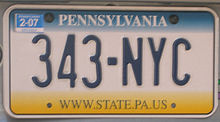 An example of a vanity license plate from Pennsylvania, when the state's official website was on the plate and not the tourism site VisitPA.com. 343 is the number of New York City Fire Department members killed on September 11, 2001.
An example of a vanity license plate from Pennsylvania, when the state's official website was on the plate and not the tourism site VisitPA.com. 343 is the number of New York City Fire Department members killed on September 11, 2001.
In some countries, people can pay extra and get "vanity plates": license plates with a custom number (character set). For example, a vanity license plate might read "MY TOY". Generally vanity plates are not allowed to have profane, offensive or obscene messages on them, and of course they must also be unique. (DMVs of states have sometimes received complaints of offensive vanity plates.[14])
Many countries allow licensed amateur radio operators to obtain license plates with their call signs printed on them, allowing public service officials controlling access to disaster areas to immediately recognize and allow operators into the areas, facilitating their provision of crucial emergency communications. Some U.S. states charge lower fees for ham radio plates than for vanity plates.[15]
In the U.S., Canada and Australia, vehicle owners may also pay extra for specialty plates: with these, the sequence of letters and numbers is chosen by the licensing agency – as with regular plates – but the owners select a plate design that is different from the normal license plate. Fees for specialty plates are usually channeled to a specific charity or organization. For example, California has issued the "Yosemite plate" and "whale tail plate," both aimed at conservation efforts in the respective domains. Some jurisdictions allow for these special plates to also be vanity plates, usually for an additional fee on top of the cost of the plate.
 Illustration of a "Euro Plate" issued in the Australian state of Victoria.
Illustration of a "Euro Plate" issued in the Australian state of Victoria.
In some Australian states, it is possible to purchase "personalized plates", where an individual can choose the color, design, and sometimes even the shape and size of the plate, as well as the displayed text. For example, the government of the state of Queensland offers a wide range of possibilities for customization.[16] Another style of plate that is common in some states of Australia is "Euro Plates", which are the same size as European plates (rather than the narrower taller Australian plates) to fit on the numberplate holders in European cars.
The "personal plate" industry in the United Kingdom is huge, with a large number of private dealers acting as agents for DVLA issues as well as holding their own or communal stock. The official term for what is often incorrectly called a "personal", "personalized" or "private" plate is a "cherished mark", as the alphanumeric code on the plate is the "index mark" — that is, the "mark" assigned to the vehicle on the central registry or "index". UK registrations or indexes cannot be owned outright by individuals, even though they may appear to have been purchased. They are issued by Government agencies and can be recalled or canceled at any time if misuse is suspected.
The main difference regarding "personal plates" between the UK and many other countries, is that drivers are not able to make, or request, their own. What is being traded is coincidences in the existing numbering system where the numbers and letters appear to spell something. For example, M15 ERY looks like MISERY or J4 MES looks similar to JAMES. Often, illegal fonts, digit-spacings or colored screw heads are used to enhance the appearance of the "word". UK legislation can require a fine of up to £1000 per offense in the case of an illegally-altered registration index mark.
The record for a personal plate sale held in the UK is £330,000, for M 1, sold at auction in Goodwood on 7 June 2006.[17]
The world record for the most expensive license plate is USD 14 million[citation needed]. The license plate "1" was bought at an auction in Abu Dhabi conducted by Emirates Auction
Temporary licence plates
Temporary Licence plate Ontario
Some jurisdictions issue temporary licence plates made of security paper for drivers waiting for plates in the mail, or other registration issues. A common length of time to have temporary plates is 30 days, although Ontario offers 10 day permits, and some U.S. states allow temporary tags to be effective for up to 90 days. Temporary licence plates are usually taped to the inside of the rear windshield, while some states require it to be in the front windshield. Expiration dates are usually hand written by regulatory employees or dealership sales personnel, but, due to easy alteration of hand written dates, some states now digitally print the date on the tag. If a driver continues to drive after the permit expires the vehicle can face impounding as an unplated vehicle.
Novelty licence plates
There also exist novelty license plates often sold in gift or novelty shops. Similar to vanity plates, these novelties are printed with an individual's name or other words or phrases, but unlike vanity plates they are not intended for legal identification of an automobile. They can be displayed in the rear window, for example, or on the front of vehicles registered in jurisdictions that only require a valid plate on the rear of the vehicle.
Novelty license plates are usually installed by motorists or automobile dealerships. While automobile dealerships may install such plates for promoting their business, motorists may install novelty license plates to express their brand preference or an affiliation with a group, state, country, athletic team, hobby, art, or custom.
Antique auto collectors may use novelty replicas of period license plates to give their show cars a dated look, or import vehicle owners may use a novelty replica of a foreign plate to give it a foreign image. Some states allow year of manufacture registrations where an original, official plate expiring on the model year of an antique car is revalidated. Wisconsin, for instance, permits the use of year-of-manufacture plates if the state-issued plates are also carried somewhere within the vehicle.
Licence plate accessories
Today, plates are commonly attached with screws that mount into threaded fittings on the vehicle but originally nut-and-bolt combinations were needed to fasten the plate to a bracket, which led to the use of varied licence plate ornaments, accessories and attachments. The most common of these include fastening bolts with ornamental heads in a myriad of styles; these are generally legal everywhere providing the plate itself is not obscured. Those bolts faced with a colored glass or plastic reflector are termed license plate jewels. Traditionally the front plate would be fastened by an amber or green jewel and the rear by a red jewel, but other colors have become available over the decades including blue, clear and, most recently, purple.
The manufacture and use of license plate toppers - attachments and accessories mounted atop plates, often as advertising premiums - has diminished because of the design of modern vehicle bodies that incorporate recessed plate mountings. But older vehicles will usually have room for such attachments that may mention vehicle dealerships, tourist attractions and petroleum companies. Some of these commercial toppers also incorporate one or more reflectors or a safety-related message. Large stand-alone glass or plastic reflectors or cataphotes - some imprinted with an advertising message - are still common plate toppers whenever registration-plate brackets are able to accommodate them.
International codes
Main article: List of international license plate codesOn the international level the license plates of different countries are distinguished by a supplementary license plate country code. This country designator is displayed in bold block uppercase on a small white oval plate or sticker on the rear of the vehicle near the number plate.
The allocation of codes is maintained by the United Nations as the Distinguishing Signs of Vehicles in International Traffic, being authorized by the UN's Geneva Convention on Road Traffic (1949) and Vienna Convention on Road Traffic (1968). Many, but far from all, vehicle codes created since the adoption of ISO 3166 coincide with either the ISO two or three letter codes.
Imitation international codes
In Canada, Mexico and the United States, where the international oval is not used on vehicles from neighbouring countries (aside from some rare Canadian cars bearing CDN ovals travelling into the U.S.), putting one on a car is a matter of personal choice. This has given rise to a tourist-driven industry of imitation international code stickers. For example, the island of Martha's Vineyard off the coast of Massachusetts has MV, while the Outer Banks region of North Carolina uses OBX. Long Beach Island, NJ uses "LBI," with the letter "I" substituted with an illustration of the island's lighthouse. The city of Key West, Florida, uses KW as part of its Conch Republic 'rebellion' from the U.S. Stickers of this sort are usually visibly different from any real international code sticker, but some places sell what could appear to be real stickers, touting that the abbreviation refers to their venue.
In the United Kingdom, imitation international codes are sometimes seen for the various parts of the country. For example, in Scotland, oval stickers with "Ecosse" or "Alba" (Scotland in French and Gaelic respectively) are occasionally seen. In Wales, drivers commonly display "CYM" to indicate Cymru (Wales).
See also
- Antique vehicle registration
- Automobile Licence Plate Collectors Association
- Automatic number plate recognition (ANPR)
- Electronic license plate
- List of international license plate codes
- Vehicle excise duty
- Vehicle identification number (VIN)
References
- ^ Robertson, Patrick (1974). The book of firsts. C. N. Potter : distributed by Crown Publishers. p. 51. http://books.google.com/books?id=yaAvAAAAMAAJ. Retrieved 13 August 2011.
- ^ De Autogids.nl (Dutch)
- ^ Road Transport (Permits) Act, CHAPTER 69:03
- ^ "Yahoo! GeoCities". Web.archive.org. 2009-10-27. Archived from the original on 2009-10-27. http://web.archive.org/web/20091027094218/http://geocities.com/mex_plates/otras/euro.html. Retrieved 2010-11-29.
- ^ "Front/Rear Plate Requirements". worldlicenceplates.com. http://www.worldlicenceplates.com/usa/US_XLPR.html. Retrieved 2010-12-19.
- ^ "License Plate Laws". javasigns.com. http://www.javasigns.com/info/category/162/article/570. Retrieved 2010-12-19.
- ^ "Nevada Department of Motor Vehicles". Dmvnv.com. http://www.dmvnv.com/platesmain.htm#Display. Retrieved 2010-11-29.
- ^ "CBC News". Archives.cbc.ca. http://archives.cbc.ca/IDC-1-73-108-664/politics_economy/nunavut/clip6. Retrieved 2010-11-29.
- ^ "NC.GOV". Doc.state.nc.us. http://www.doc.state.nc.us/EPRISE/about/work.html. Retrieved 2010-11-29.
- ^ Government of Ontario, Canada / Gouvernement de l'Ontario, Canada (English), (French)
- ^ "EUR-Lex - 31998R2411 - EN". Eur-lex.europa.eu. http://eur-lex.europa.eu/LexUriServ/LexUriServ.do?uri=CELEX:31998R2411:EN:NOT. Retrieved 2010-11-29.
- ^ "Registration stickers a thing of the past"
- ^ "License Plates of New Zealand". Worldlicenseplates.com. http://www.worldlicenseplates.com/world/PA_NZEA.html. Retrieved 2010-07-05.
- ^ The Smoking Gun: Public Documents, Mug Shots
- ^ "Oregon DMV Regular-Issue License Plates". Oregon.gov. 2010-07-29. http://www.oregon.gov/ODOT/DMV/vehicle/plateregular.shtml#ham. Retrieved 2010-11-29.
- ^ "Personalised Plates Queensland". Ppq.com.au. 2010-09-15. http://www.ppq.com.au. Retrieved 2010-11-29.
- ^ "News article". Numberplates.com. http://www.numberplates.com/stories/m1.asp. Retrieved 2010-11-29.
External links
Organizations
- Automobile License Plate Collectors Association (ALPCA) - Group of license plate collectors and enthusiasts, based in North America.
- European Registration Plate Association (Europlate) - Similar to ALPCA, but based in Europe.
Information resources
- LicensePlates.cc - A site for plate enthusiasts featuring regular news updates, a huge list of web links, and various other tools.
- PL8S.COM - Various resources for plate collectors, including an extensive list of jurisdictions issuing plates.
- Search banned Wisconsin license plates - A searchable database of nearly 8,000 banned plates.
- Plate-Trader - A UK based number plate classifieds website with a useful guides section
- IrishLicensePlates.com - Database of vehicles registered in Ireland
Photo galleries
- In Praise of Old License Plates - slideshow by Life magazine
- UK Car Number Plates - Thousands of photos of number plates spotted in the UK.
- License Plate Factory - Step-by-step account of how the state of Michigan creates license plates.
- License Plate Mania - A large gallery of number plates from around the world.
- License Plates of the World - Extensive gallery of global license plates, along with related information.
- Olav's License Plate Pictures - A Europlate member's gallery of license plates from around the world, most spotted in Norway.
- The License Plate Shack - An ALPCA member's gallery of over 14,000 plates, mainly from North America.
- License Plate Genie - A directory site for identifying North American cars based on license plate numbers.
- Avto-Nomer.ru - A large gallery of Russian, Ukrainian, Byelorussian, Kazakh and Soviet license plates.
Vehicle registration plates of Africa Sovereign
states- Algeria
- Angola
- Benin
- Botswana
- Burkina Faso
- Burundi
- Cameroon
- Cape Verde
- Central African Republic
- Chad
- Comoros
- Democratic Republic of the Congo
- Republic of the Congo
- Côte d'Ivoire (Ivory Coast)
- Djibouti
- Egypt
- Equatorial Guinea
- Eritrea
- Ethiopia
- Gabon
- The Gambia
- Ghana
- Guinea
- Guinea-Bissau
- Kenya
- Lesotho
- Liberia
- Libya
- Madagascar
- Malawi
- Mali
- Mauritania
- Mauritius
- Morocco
- Mozambique
- Namibia
- Niger
- Nigeria
- Rwanda
- São Tomé and Príncipe
- Senegal
- Seychelles
- Sierra Leone
- Somalia
- South Africa
- South Sudan
- Sudan
- Swaziland
- Tanzania
- Togo
- Tunisia
- Uganda
- Zambia
- Zimbabwe
States with limited
recognition- Sahrawi Arab Democratic Republic
- Somaliland
Dependencies and
other territories- Canary Islands / Ceuta / Melilla / Plazas de soberanía (Spain)
- Madeira (Portugal)
- Mayotte / Réunion (France)
- Saint Helena / Ascension Island / Tristan da Cunha (United Kingdom)
- Western Sahara
Vehicle registration plates of Asia Sovereign
states- Afghanistan
- Armenia
- Azerbaijan
- Bahrain
- Bangladesh
- Bhutan
- Brunei
- Burma (Myanmar)
- Cambodia
- People's Republic of China
- Cyprus
- East Timor (Timor-Leste)
- Egypt
- Georgia
- India
- Indonesia
- Iran
- Iraq
- Israel
- Japan
- Jordan
- Kazakhstan
- North Korea
- South Korea
- Kuwait
- Kyrgyzstan
- Laos
- Lebanon
- Malaysia
- Maldives
- Mongolia
- Nepal
- Oman
- Pakistan
- Philippines
- Qatar
- Russia
- Saudi Arabia
- Singapore
- Sri Lanka
- Syria
- Tajikistan
- Thailand
- Turkey
- Turkmenistan
- United Arab Emirates
- Uzbekistan
- Vietnam
- Yemen
States with limited
recognition- Abkhazia
- Nagorno-Karabakh
- Northern Cyprus
- Palestine
- Republic of China (Taiwan)
- South Ossetia
Dependencies and
other territoriesVehicle registration plates of Europe Sovereign
states- Albania
- Andorra
- Armenia
- Austria
- Azerbaijan
- Belarus
- Belgium
- Bosnia and Herzegovina
- Bulgaria
- Croatia
- Cyprus
- Czech Republic
- Denmark
- Estonia
- Finland
- France
- Georgia
- Germany
- Greece
- Hungary
- Iceland
- Ireland
- Italy
- Kazakhstan
- Latvia
- Liechtenstein
- Lithuania
- Luxembourg
- Macedonia
- Malta
- Moldova
- Monaco
- Montenegro
- Netherlands
- Norway
- Poland
- Portugal
- Romania
- Russia
- San Marino
- Serbia
- Slovakia
- Slovenia
- Spain
- Sweden
- Switzerland
- Turkey
- Ukraine
- United Kingdom
- Vatican City
States with limited
recognition- Abkhazia
- Kosovo
- Nagorno-Karabakh
- Northern Cyprus
- South Ossetia
- Transnistria
Dependencies
and other territories- Åland
- Faroe Islands
- Gibraltar
- Guernsey
- Jan Mayen
- Jersey
- Isle of Man
- Svalbard
Other entities - European Union
Vehicle registration plates of North America Sovereign states Dependencies and
other territories- Anguilla
- Aruba
- Bermuda
- Bonaire
- British Virgin Islands
- Cayman Islands
- Curaçao
- Greenland
- Guadeloupe
- Martinique
- Montserrat
- Puerto Rico
- Saint Barthélemy
- Saint Martin
- Saint Pierre and Miquelon
- Saba
- Sint Eustatius
- Sint Maarten
- Turks and Caicos Islands
- United States Virgin Islands
Vehicle registration plates of Oceania Sovereign states - Australia
- East Timor (Timor-Leste)
- Fiji
- Indonesia
- Kiribati
- Marshall Islands
- Federated States of Micronesia
- Nauru
- New Zealand
- Palau
- Papua New Guinea
- Samoa
- Solomon Islands
- Tonga
- Tuvalu
- Vanuatu
Dependencies and
other territories- American Samoa
- Christmas Island
- Cocos (Keeling) Islands
- Cook Islands
- Easter Island
- French Polynesia
- Guam
- Hawaii
- New Caledonia
- Niue
- Norfolk Island
- Northern Mariana Islands
- Pitcairn Islands
- Tokelau
- Wallis and Futuna
Categories:- Vehicle registration plates
- Identifiers
Wikimedia Foundation. 2010.




